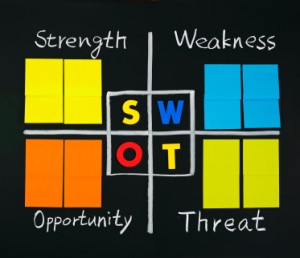The SWOT Analysis (“Strengths, We aknesses, Opportunities and Threats”) has been a staple of the business planning toolkit for decades. And for good reason – it’s an excellent exercise. It forces us to review in detail what our company is good at, what we don’t do well, where we see opportunity, and where we’re vulnerable.
aknesses, Opportunities and Threats”) has been a staple of the business planning toolkit for decades. And for good reason – it’s an excellent exercise. It forces us to review in detail what our company is good at, what we don’t do well, where we see opportunity, and where we’re vulnerable.
But today, I’m suggesting you take the SWOT Analysis outside your company – Conduct a SWOT Analysis of each of your competitors.
Make sure you wear 2 caps when you do so –conduct the SWOT Analysis from the perspective of the competitor as well as from what you and your teammates know and believe about that company. Comparing the competition’s intent with marketplace reality can be very revealing.
Invest the energy and time necessary to do a thorough SWOT Analysis. Give the person/team you assign this task enough time to research and to interview various members of your in-house crew as well as to talk with prospects, clients, and other vendors in your field. Build a full view of the competitor.
Creating these analyses is terrific competitive intel. Your marketing team can use it to create profiles of each competitor and develop ways to counter their selling points and identify new messages, media choices, and product positioning that will help you stand apart from the crowd.
Now, take it a step further. Once you’ve assessed your competition individually, build a matrix that graphically presents all competitors on a single chart. I suggest you graph one parameter/point at a time, otherwise your graph could be illegible.
You can design the graph and its scale however you think makes sense for your industry. Place each competitor on this graph. Then place yourself. Look for holes in the chart. Are there opportunities you can seize? Are there common weaknesses you can attack? Can you turn a strategic threat into a chance to establish a strength that the other players lack?
This is competitive research and analysis at its finest. Using market intel to chart corporate, product, market, and sales growth opportunities.
What competitive factors do you track? Have you found unique ways to compare the players in your field that help you identify opportunities? Share them with us!
